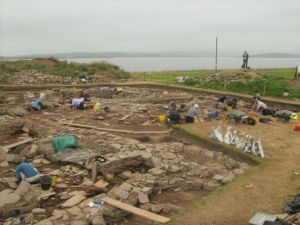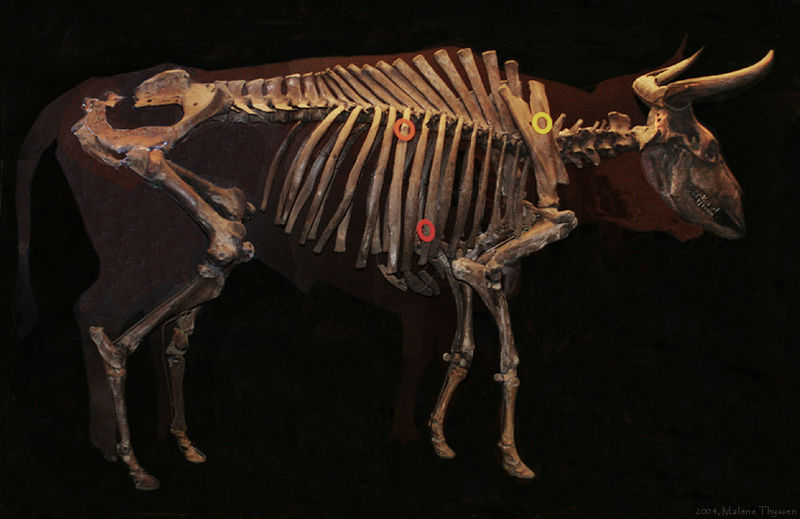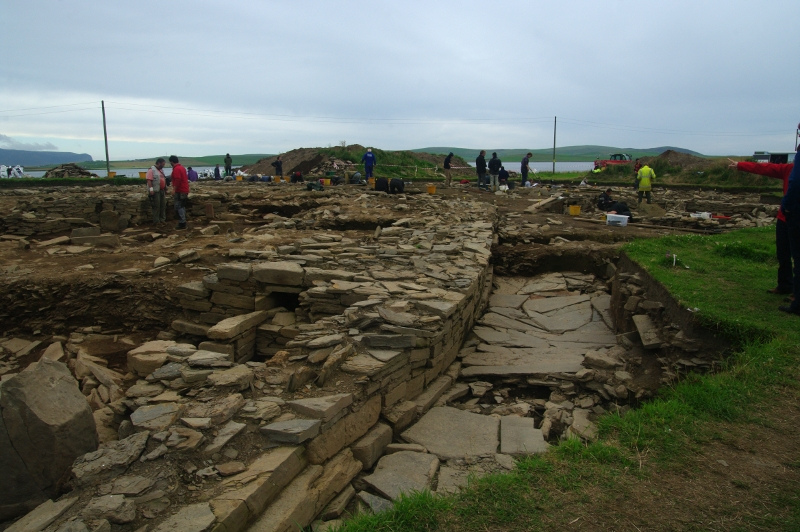
It wasn’t a buried cache of gold or silver that excavators came across as they methodically dug down through the remains of one of Scotland’s most ancient archaeological sites. But in a very important sense, the discovery was equally exciting.
They were the skeletal remains of an animal—a very, very big one. And a very old one.
“It is so big that there was an immediate need for an expert opinion,” reported the Dig Diary blogger for the Ness of Brodgar Excavations project.
So they called upon Jen Harland, an expert at identifying faunal remains.
“She has confirmed that the bones belong to an enormous cow—so big indeed that it is probably off the scale for the biggest known modern cow and into the range for an aurochs.”*
This is considered big news, because the aurochs, a huge, prehistoric ancestor to the modern day cow, is now extinct, the last one having died in the Jaktorów Forest, Poland in 1627. But even during Neolithic times, they had already become relatively rare.
Thus far, the animal’s massive horn core has been revealed, along with part of the skull. But much more work needs to be done when the excavators return for the next season. “Further identification will be needed and this will have to wait until next year when the contexts can be properly excavated without the need to rush,” continues the blog report. “However, it will have important implications for our understanding of the agricultural economy of the Neolithic in Orkney, and for the range of animals present at that time.”*
__________________________________
 The aurochs pictured above is dated to about 7500 BC and is one of two very well preserved aurochs skeletons found in Denmark. The Vig-aurochs can be seen at the National Museum of Denmark. The circles indicate where the animal was wounded by arrows in antiquity. Malene Thyssen, Wikimedia Commons
The aurochs pictured above is dated to about 7500 BC and is one of two very well preserved aurochs skeletons found in Denmark. The Vig-aurochs can be seen at the National Museum of Denmark. The circles indicate where the animal was wounded by arrows in antiquity. Malene Thyssen, Wikimedia Commons
__________________________________
 View of the excavation site of Ness of Brodgar. Genevieve Romier, Wikimedia Commons
View of the excavation site of Ness of Brodgar. Genevieve Romier, Wikimedia Commons
__________________________________
Archaeologists have been excavating in earnest at this now famous Neolithic Era site in the West Mainland of Orkney in northern Scotland ever since a geophysical survey in 2002 revealed anomalies that indicated a buried settlement complex, and then ploughing turned up a large, notched stone slab in a field in 2003. Radiocarbon dates from excavations have since shown that the site was a prehistoric complex that was used for 1,000 years—from at least 3200 BC to 2300 BC.
The animal remains are among the latest of a string of remarkable finds. Other discoveries have revealed a sequence of Neolithic structures, including a large oval structure enclosed by a monumental wall, a symmetrical building, and a structure measuring 25 metres (82 feet) long by 20 meters (65 feet) wide, with the remains of five-meter-thick outer walls still standing at a height of about one meter (three feet). The latter is considered “one of the largest, if not the largest, stone-built Neolithic non-funerary structures in Britain.”* Site investigators have also found evidence that the Neolithic people who lived at the site were using paint to decorate the buildings.
More information about the Ness of Brodgar excavations can be found here.
_______________________________________________
*http://www.orkneyjar.com/archaeology/nessofbrodgar/
Cover Photo, Top Left: View of excavation at Ness of Brodgar. Tine, Wikimedia Commons
_______________________________________________
Travel and learn with Far Horizons.
Read about the most fascinating discoveries with a premium subscription to Popular Archaeology Magazine. Find out what Popular Archaeology Magazine is all about. AND MORE:
On the go? Get the smartphone version of Popular Archaeology as an app or as an ebook.
Popular Archaeology’s annual Discovery Edition eBook is a selection of the best stories published in Popular Archaeology Magazine in past issues, with an emphasis on some of the most significant, groundbreaking, or fascinating discoveries in the fields of archaeology and paleoanthropology and related fields. At least some of the articles have been updated or revised specifically for the Discovery edition. We can confidently say that there is no other single issue of an archaeology-related magazine, paper print or online, that contains as much major feature article content as this one. The latest issue, volume 2, has just been released. Go to the Discovery edition page for more information.







